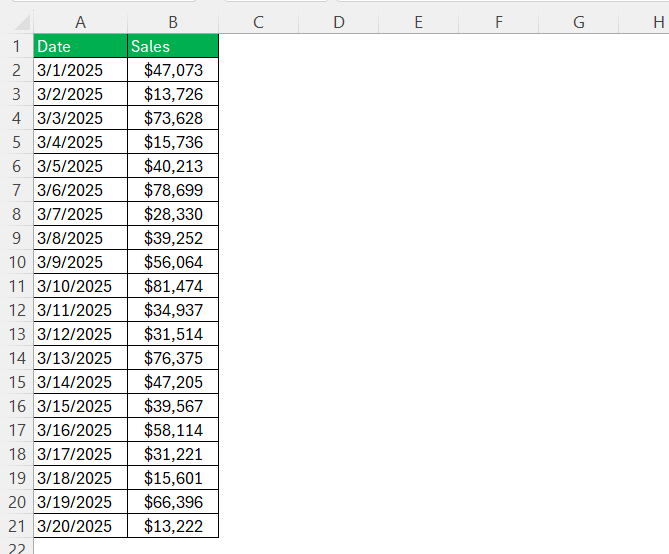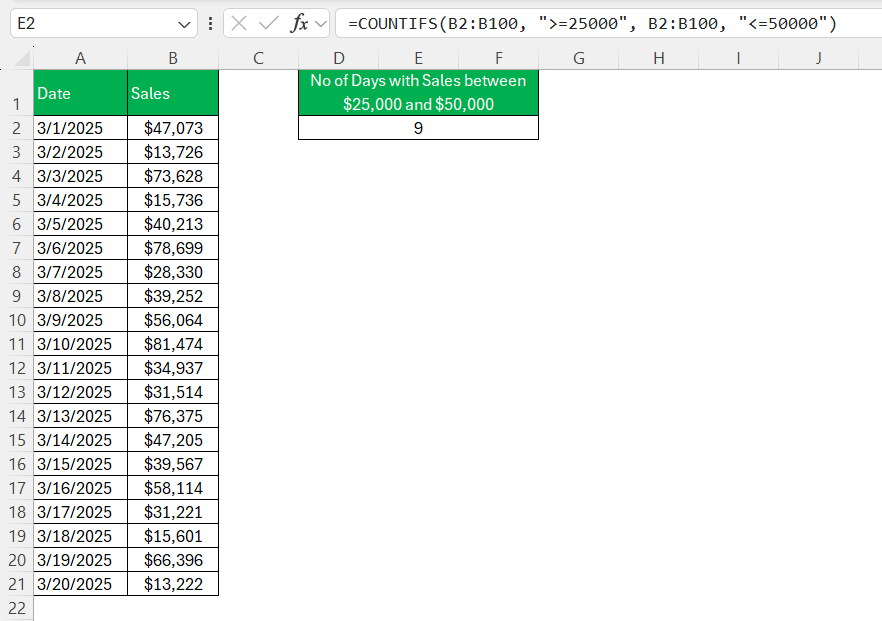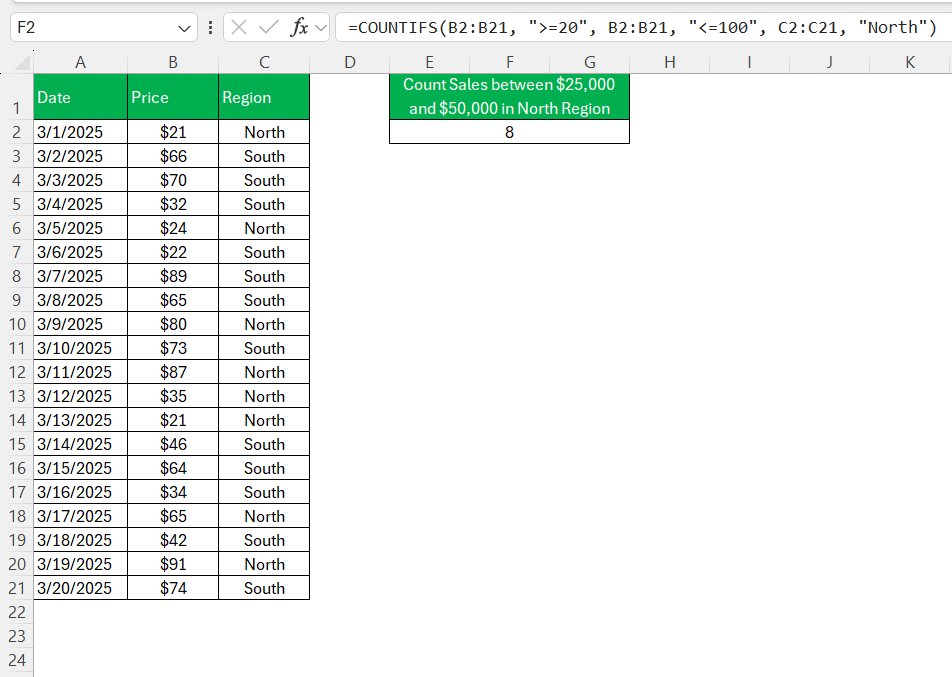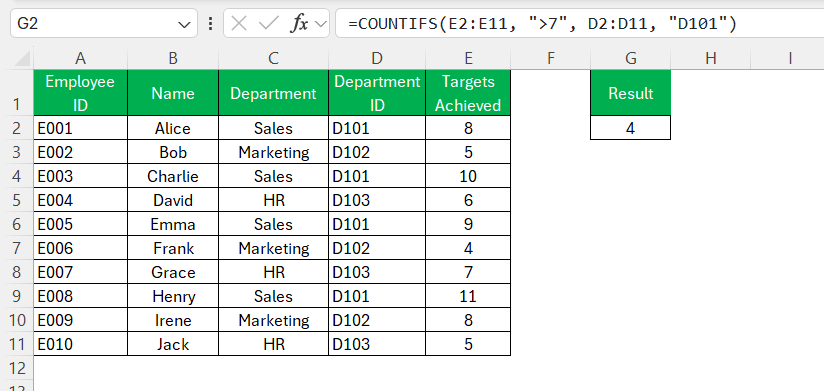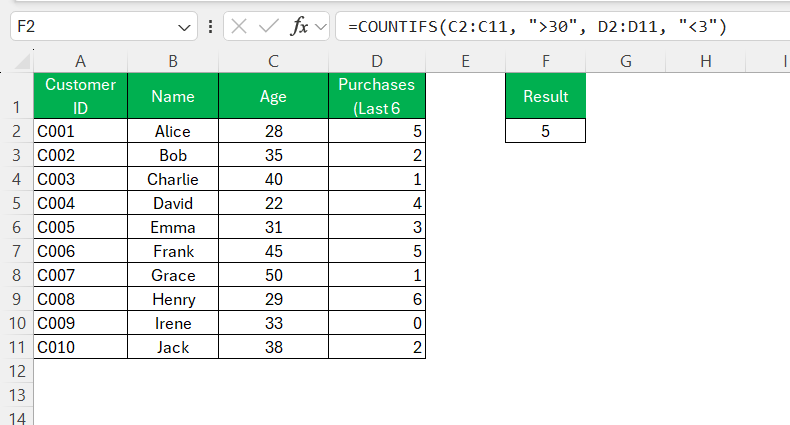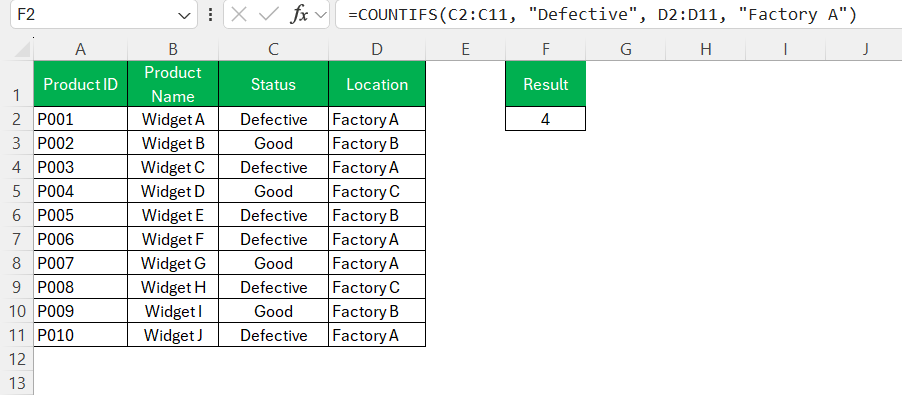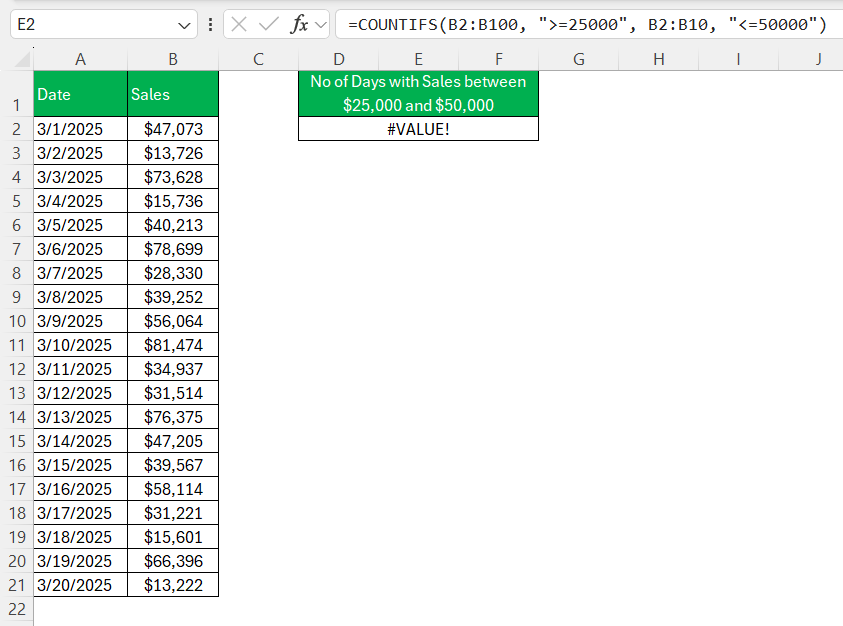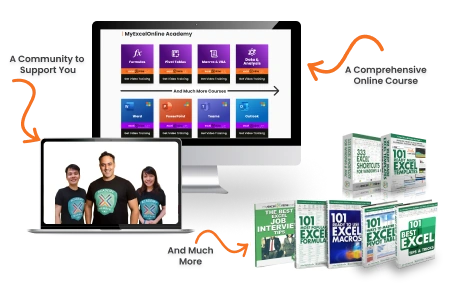In today’s data-driven world, harnessing the power of Excel is not just beneficial; it’s essential. One of Excel’s most versatile tools is the COUNTIFS function, which allows you to quantify data within multiple sets of criteria seamlessly. Whether you’re managing a small project, analyzing sales data, or working on large datasets, understanding how to effectively use COUNTIFS can drive efficiency and insight.
In this guide, I’ll walk you through the ins and outs of this powerful function, particularly focusing on how to count between two numbers. With practical tips and examples, you’ll be ready to tackle complex data challenges effortlessly.
Key Takeaways:
- COUNTIFS is a powerful Excel function that allows counting data based on multiple conditions across different ranges.
- It enhances accuracy and efficiency by eliminating the need for complex, nested formulas.
- Proper data organization, including consistent formatting and eliminating duplicates, is crucial for reliable results.
- COUNTIFS can handle various data types, including numbers, text, and dates, making it useful for diverse analytical tasks.
- Common errors, such as mismatched range sizes or incorrect syntax, can be easily fixed by ensuring proper formatting and logical structure.
Table of Contents
Mastering the COUNTIFS Function
What is COUNTIFS?
COUNTIFS is a robust statistical function in Excel designed to count the number of cells that meet multiple criteria across different ranges. Unlike the COUNTIF function, which is limited to a single condition, COUNTIFS can evaluate up to 127 range/criteria pairs, making it ideal for complex data analysis tasks.
By using COUNTIFS, you can create versatile queries that filter through datasets based on numerous parameters, providing a clear and focused count of relevant data points. This makes it an indispensable tool for users needing precise and conditional data analysis in fields ranging from finance to logistics.
Advantages of Using COUNTIFS in Data Analysis
Employing the COUNTIFS function in data analysis offers several compelling advantages. Firstly, it enhances accuracy by allowing multiple criteria within a single formula, ensuring data is filtered precisely as per specified conditions. This is particularly useful in scenarios requiring stringent evaluation, such as identifying sales numbers within a specific range or tracking attendance across multiple events.
Secondly, its capacity to handle diverse data types—numbers, text, and dates—provides flexibility across various datasets. Additionally, COUNTIFS promotes efficiency by reducing the need for complex, nested IF statements, simplifying spreadsheet management, and reducing errors. Overall, it empowers users to conduct comprehensive analyses swiftly, deriving insightful conclusions with minimal effort.
Setting Up Your Spreadsheet for Success
Preparing Your Data
Before utilizing the COUNTIFS function, it’s crucial to ensure your data is well-organized, as this impacts both the accuracy and efficiency of your analysis. Begin by arranging your dataset in a tabular format with clear, descriptive headers that reflect the content of each column. This not only aids in identifying the data you’re working with but also makes it easier to apply specific criteria.
Moreover, ensure consistency in data types within each column. For instance, numerical data should be uniformly formatted to avoid discrepancies, and text entries should follow the same pattern, such as case sensitivity, to ensure COUNTIFS processes them correctly. Lastly, check for and rectify any anomalies or duplicates in your data that could skew results. By preparing your data meticulously, you lay a strong foundation for effective and reliable data analysis using the COUNTIFS function.
COUNTIFS Formula Breakdown
Syntax and Structure Explained
The COUNTIFS function’s syntax is designed for evaluating multiple conditions simultaneously. It follows this structure:
=COUNTIFS(criteria_range1, criteria1, [criteria_range2, criteria2], …)
- criteria_range1: This is the first range of cells you want evaluated.
- criteria1: Specifies the condition that must be met within the first range.
- [criteria_range2, criteria2]: These are optional additional pairs of range and criteria, allowing you to layer multiple conditions. You can include up to 127 range/criteria pairs in a single function.
Each range should have the same number of cells, ensuring consistency across your criteria applications. The criteria can be any logical expressions involving numbers, text, or even wildcards. By constructing your formula using this straightforward syntax, COUNTIFS becomes a powerful tool for streamlined and complex data analysis.
Practical Applications of COUNTIFS
Count Between Two Numbers
Counting instances between two values using COUNTIFS is a straightforward process, especially useful for analyzing numerical datasets. To achieve this, you will need to specify a range within which the cells must fall. Here’s a step-by-step explanation:
STEP 1: Select the range of data you want to analyze. For example, if you’re evaluating sales figures from column B, use B2:B100.
STEP 2: Define the lower and upper limits of the values you’re interested in. For instance, to count sales figures between $25,000 and $50,000, your criteria will be “>25000” and “<=50000”.
STEP 3: Incorporate the selected range and criteria into the following formula:
=COUNTIFS(B2:B100, “>=25000”, B2:B100, “<=50000”)
This formula will count the number of cells within the specified range that have values falling between $25,000 and $50,000, providing a precise tally of relevant instances. By using COUNTIFS in this manner, you can efficiently extract insights from large datasets, ensuring your analysis remains focused and relevant to specific parameters.
Real-Life Examples You Can Apply Today
Leveraging COUNTIFS in real-world scenarios can profoundly enhance data analysis efficiency. Here are a few practical applications:
Cross-Category Analysis: For instance, if you need to count sales that not only fall within a certain price range, say between $20 and $100, but also belong to a specific region or category, you can structure your formula to include these additional layers:
=COUNTIFS(PriceRange, “>=20”, PriceRange, “<=100”, RegionRange, “North”)
Employee Performance: In performance reviews, you might want to count employees who exceed a number of targets and also work within a particular department. By adding criteria for both the number of targets and department ID, you streamline employee evaluations.
Market Analysis: Combine customer-specific criteria, such as age and purchase behavior, to better understand target demographics:
=COUNTIFS(AgeRange, “>30”, PurchaseRange, “<3”)
Quality Control: If you manage a product line, count items that need re-evaluation by checking for defects across multiple thresholds and locations:
=COUNTIFS(ProductRange, “Defective”, QualityLocationRange, “Factory A”)
These examples illustrate the versatility of COUNTIFS, showcasing its application across various sectors to drive informed decision-making. By utilizing this function, professionals can focus on areas of interest and make data-driven strategies that are both precise and actionable.
Troubleshooting Common Issues
While using COUNTIFS, you might encounter various issues that can disrupt your analysis. Knowing how to troubleshoot these can save time and enhance accuracy:
- Mismatched Range Sizes: One of the most common errors occurs when the criteria ranges do not match in size. Ensure all the criteria_ranges specified have the same number of cells. Simply aligning their lengths often resolves error messages.
- Typing Errors and Syntax: Double-check your formula for typos or syntax errors, such as misplaced quotes and incorrect logical operators. Ensure criteria involving text are enclosed in quotation marks, and logical operators in numbers have quotes.
- Incorrect Cell References: Ensure cell references are accurate and correspond to the intended data. If your data changes dynamically, use absolute references (e.g., $A$1) to avoid errors during cell copying.
- Inconsistent Data Types: When criteria encompass diverse data types, results may skew. Ensure uniformity; for example, numerical criteria should not be applied to text data ranges.
- Logical Operator Errors: Using “<” or “>” without enclosing them in quotes will yield incorrect outcomes. Always surround numerical operators in quotes to ensure proper function execution.
By addressing these common issues, you can enhance the effectiveness and reliability of your COUNTIFS analyses. Familiarity with these troubleshooting techniques ensures that your functions work seamlessly, providing accurate and trustworthy results. Remember, a small amount of preventive maintenance with your formula setup can prevent larger issues down the line.
FAQs
How does COUNTIFS differ from COUNTIF?
COUNTIFS differs from COUNTIF primarily in the number of criteria it can handle. While COUNTIF is designed to count cells based on a single condition within one range, COUNTIFS allows you to apply multiple criteria across different or the same ranges. This makes COUNTIFS a more versatile option for complex datasets where multiple conditions need to be evaluated simultaneously.
Can COUNTIFS handle text and numbers simultaneously?
Yes, COUNTIFS can handle both text and numbers simultaneously. You can apply criteria for text and numerical data within the same formula, allowing for comprehensive data analysis across varied data types. Just ensure each condition is correctly formatted and associated with the appropriate range.
How do I use COUNTIFS with date ranges?
To use COUNTIFS with date ranges, specify your date criteria within the formula. For instance, to count entries between two dates in column A, such as January 1, 2023, and January 31, 2023, use:
=COUNTIFS(A2:A100, “>=01/01/2023”, A2:A100, “<=01/31/2023”)
Ensure dates are formatted correctly, and criteria are enclosed in quotes for precise count results.
What should I do if my COUNTIFS formula isn’t working?
If your COUNTIFS formula isn’t working, first check for common issues such as mismatched range sizes, ensuring all ranges have the same number of cells. Verify the syntax for typographical errors, especially in logical operators and quotes. Confirm that your cell references are correct and consistent with your data layout. Lastly, make sure data types in your criteria and ranges match appropriately, with text in quotes and correct formatting for numbers and dates.
How to count data between two numbers in Excel?
To count data between two numbers in Excel, use the COUNTIFS function. Specify the range where your data is located and define the criteria for your lower and upper limits. For example, if you want to count values in range B2:B100 that fall between 10 and 50, use:
=COUNTIFS(B2:B100, “>=10”, B2:B100, “<=50”)
This formula provides the count of cells with values meeting these conditions within the specified range.
John Michaloudis is a former accountant and finance analyst at General Electric, a Microsoft MVP since 2020, an Amazon #1 bestselling author of 4 Microsoft Excel books and teacher of Microsoft Excel & Office over at his flagship MyExcelOnline Academy Online Course.

